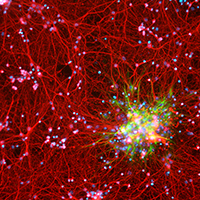Quantitative, structural and molecular changes in neuroglia of aging mammals: A review

Accepted: 27 May 2021
HTML: 11
All claims expressed in this article are solely those of the authors and do not necessarily represent those of their affiliated organizations, or those of the publisher, the editors and the reviewers. Any product that may be evaluated in this article or claim that may be made by its manufacturer is not guaranteed or endorsed by the publisher.
Authors
The neuroglia of the central and peripheral nervous systems undergo numerous changes during normal aging. Astrocytes become hypertrophic and accumulate intermediate filaments. Oligodendrocytes and Schwann cells undergo alterations that are often accompanied by degenerative changes to the myelin sheath. In microglia, proliferation in response to injury, motility of cell processes, ability to migrate to sites of neural injury, and phagocytic and autophagic capabilities are reduced. In sensory ganglia, the number and extent of gaps between perineuronal satellite cells – that leave the surfaces of sensory ganglion neurons directly exposed to basal lamina– increase significantly. The molecular profiles of neuroglia also change in old age, which, in view of the interactions between neurons and neuroglia, have negative consequences for important physiological processes in the nervous system. Since neuroglia actively participate in numerous nervous system processes, it is likely that not only neurons but also neuroglia will prove to be useful targets for interventions to prevent, reverse or slow the behavioral changes and cognitive decline that often accompany senescence.
How to Cite
PAGEPress has chosen to apply the Creative Commons Attribution NonCommercial 4.0 International License (CC BY-NC 4.0) to all manuscripts to be published.
Similar Articles
- Wenjing Liu, Yongchun Zhang, Cheng Liang, Xuefang Jiang, Developmental expression of calretinin in the mouse cochlea , European Journal of Histochemistry: Vol. 68 No. 4 (2024)
- G. Laguna Hernández, A.E. Brechú-Franco, I. De la Cruz-Chacón, A.R. González-Esquinca, Histochemical detection of acetogenins and storage molecules in the endosperm of Annona macroprophyllata Donn Sm. seeds , European Journal of Histochemistry: Vol. 59 No. 3 (2015)
- G. Perrone, S. Morini, D. Santini, C. Rabitti, B. Vincenzi, R. Alloni, A. Antinori, P. Magistrelli, R. Lai, C. Cass, J. R. Mackey, R. Coppola, G. Tonini, A. Onetti Muda, Human equilibrative nucleoside transporter 1 and carcinoma of the ampulla of Vater: expression differences in tumour histotypes , European Journal of Histochemistry: Vol. 54 No. 3 (2010)
- D.E. Korzhevskii, E.G. Sukhorukova, O.V. Kirik, I.P. Grigorev, Immunohistochemical demonstration of specific antigens in the human brain fixed in zinc-ethanol-formaldehyde , European Journal of Histochemistry: Vol. 59 No. 3 (2015)
- Kazuhiko Hashimoto, Yutaka Oda, Fumihisa Nakamura, Ryosuke Kakinoki, Masao Akagi, Lectin-like, oxidized low-density lipoprotein receptor-1-deficient mice show resistance to age-related knee osteoarthritis , European Journal of Histochemistry: Vol. 61 No. 1 (2017)
- X. Xu, S. Guan, B. He, J. Wang, Active role of the predecidual-like zone in endometrial shedding in a mouse menstrual-like model , European Journal of Histochemistry: Vol. 57 No. 3 (2013)
- Kazuhiko Hashimoto, Shunji Nishimura, Tomohiko Ito, Masao Akagi, Characterization of PD-1/PD-L1 immune checkpoint expression in soft tissue sarcomas , European Journal of Histochemistry: Vol. 65 No. 3 (2021)
- Danielle Maximo, Diego Demarco, Style head in Apocynaceae: a very complex secretory activity performed by one tissue , European Journal of Histochemistry: Vol. 68 No. 1 (2024): 1954-2024: 70 Years of Histochemical Research
- JH Lee, SK Ku, HS Lee, H Kitagawa, An immunohistochemical study of endocrine cells in the pancreas of the Red-bellied frog (Bombina orientalis) , European Journal of Histochemistry: Vol. 47 No. 2 (2003)
- Xiaoying Yang, Xuhao Liu, Fengcheng Song, Hao Wei, Fuli Gao, Haolin Zhang, Yingying Han, Qiang Weng, Zhengrong Yuan, Seasonal expressions of GPR41 and GPR43 in the colon of the wild ground squirrels (Spermophilus dauricus) , European Journal of Histochemistry: Vol. 66 No. 1 (2022)
<< < 26 27 28 29 30 31 32 33 34 35 > >>
You may also start an advanced similarity search for this article.

 https://doi.org/10.4081/ejh.2021.3249
https://doi.org/10.4081/ejh.2021.3249










